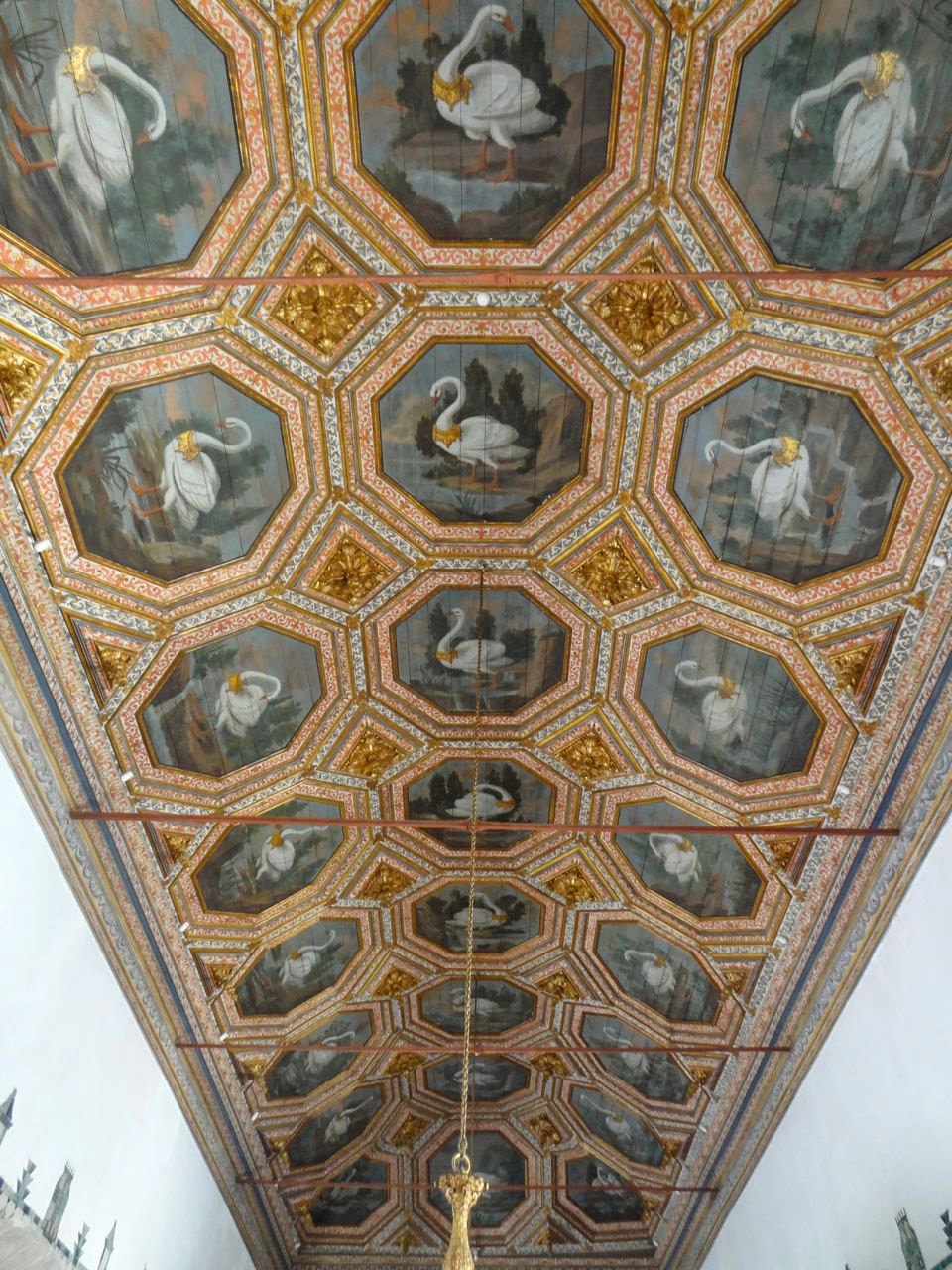With its rippling mountains, dewy forests thick with ferns and lichen, exotic gardens and glittering palaces, Sintra is like a page torn from a fairy tale. A Unesco World Heritage listed village, Sintra is dotted with pastel-hued fortresses folded into luxuriant hills that roll down to the cool blue Atlantic. Celts worshipped their moon god here, the Moors built a precipitous castle, and 18th-century Portuguese royals swanned around its dreamy gardens. Near the coastal city of Estoril, the majestic Sintra Mountains cast a veil of mystery over the town nestling on its northern slopes. Both the hills and the surrounding area have been classified by UNESCO as a World Heritage site both for their cultural significance and for their outstanding natural beauty. An easy day trip from Lisbon, we headed up the coast for a magical day in the captivating city of Sintra.
The Moorish-style entry gate into The Pena Palace courtyard
The ornate formal gate into the Pena Palace
A fantastically surreal archway at the Palace
Flowers were in bloom all around the Pena Palace
The Moorish-style courtyard with elaborate tile work from which the Portuguese became inspired and became known for producing for centuries after
Detail of the tile work
Inside the royal palace
A UNESCO restorer working on damaged frescoes
The original kitchen and copper pots in the palace
View over the palace from the rooftops
Another view over the palace and the surrounding mountains
One of the palace's many turrets
View of the palace as we left by foot through the Royal Forest
View of a Moorish Castle in the distance
A cobblestone walkway leads from the palace through the Royal Forest to the old town of Sintra
The old narrow cobblestone streets of the village of Sintra
A small restaurant in the village where we stopped for lunch
A basket of bread arrives as we sit down
A plate of local Sintra cheese
A bowl of sweet briny olives
A cold beer 'hits the spot' on a hot day exploring Sintra's palaces
Hot Carrot and Potato Soup
Bacalhau a Gomes de Sa, a Portuguese dish made of layers of salt cod, potato and sautéed onions
Bacalhau a Gomes de Sa with salad
A bowl of chilled Mango Pudding tops off our 'Orange Meal' as I dubbed it
View of the village from the National Palace of Sintra
The National Palace of Sintra fountain
The fountain shows how close the National Palace is to the centre of the village
The only surviving palace from the Middle Ages in Portugal, the National Palace of Sintra was the royal palace for summer holidays and hunting. The conical twin white chimneys of the Palace are the town's most recognizable landmarks. There's probably been a palace here since Moorish times, although the current structure, also known as the Paço Real, dates from the late 14th century. It's the only surviving royal palace in Portugal from the Middle Ages, and displays a spectacular combination of Moorish, Gothic and Manueline architecture. The chapel has Moorish-influenced azulejos (tile work) from the 15th and 16th centuries. The breathtaking ceiling of the Sala das Armas is painted with the coats of arms of 72 noble families, and the grand Sala dos Cisnes has a remarkable ceiling of painted swans. The Sala das Pegas (magpies) figures in a well-known tale about Dom João I (1385–1433) and his love affair with a lady-in-waiting. The king had the room painted with as many magpies as there were chattering court ladies, poking fun at the court gossips as loose-tongued birds.
The two conical chimneys are the palace's most recognizable architectural feature
The sunlit bathed interior courtyard of the palace
A Moorish-style room decorated with very early 'azulejos', or tile work
A detail of the early tiles that were quite rough and rudimentary looking
A gorgeous chandelier in the Room of the Swans
The ceiling is overwhelming with all the paintings of regal swans
Each swan has a royal crown around its neck
The spectacular Dining Room with blue tile walls and sumptuous carved ceiling with the coats of arms of noble families
The ceramic wall shows scenes of royal life
A detail of a royal cherub
The carved painted ceiling with the coats of arms of the areas noble families
The Magpie Room
The Royal Chapel
Restorers at work in the chapel
The Queluz National Palace was inspired, in part, by the palace at Versailles. The salmon-pink rococo edifice was ordered as a royal summer residence by Dom Pedro III in 1747. Architect Mateus Vicente de Oliveira took five years to make the place habitable; Frenchman Jean-Baptiste Robillon spent 40 more executing a detailed Baroque plan that also comprised imported trees and statues, and azulejo-lined canals and fountains. You can tour the apartments and elegant staterooms, including the frescoed Music Salon, the Hall of Ambassadors, and the mirrored Throne Room with its crystal chandeliers and gilt trim. Some are now used for concerts and state visits, while the old kitchens have been converted into an ordinary café and a fancy restaurant with an imposing open fireplace and a vast oak table.
The magnificent Queluz Palace
One of the palace's ornate rooms
Versaille is certainly the palace Queluz most resembles
The ballroom at the Queluz Palace
The Royal Chapel
A staircase into the breathtaking Palace gardens
The bridel path for horses in the royal gardens
View of the palace though the gardens
Detail of one of the garden's many fountains
A cherub gazing into the garden
The precious pink exterior of the palace from the beautiful gardens























































No comments:
Post a Comment